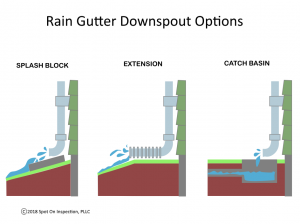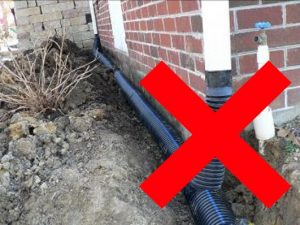
Rain Gutter Downspout Options
Many Houston homes have rain gutter systems to carry rain water from the roof covering away from the foundation. A very common deficiency I see during rain gutter inspections are rain gutter discharge tubes pouring water directly on to the ground right next to the house. This creates an area of water against the foundation. Excessive moisture in expansive clay soils may cause pressure and/or foundation movement/damage. Eventually, this discharge will erode the soil and create an area of ponding, making the situation worse.
There are several options for gutter discharge to prevent foundation damage. The first option, discharge on to a concrete splash block requires adequate slope away from the foundation to be effective. The slope must be at least 12 inches in the first 10 feet for splash blocks to be effective in Houston.  We have periods of extreme rain and anything less than this slope could result in temporary flooding at the rain gutter discharge and we don’t want any water penetrating into the structure.
We have periods of extreme rain and anything less than this slope could result in temporary flooding at the rain gutter discharge and we don’t want any water penetrating into the structure.
If this slope is not available, an extension directing the water at least 6 feet away from the foundation or a catch basin connected to subterranean drainage should be used.
If an extension is used the discharge point must be visible so that clogs may be detected. Be sure to use splash block or other method at the discharge point to prevent soil erosion.
Do not direct pipe gutters into subterranean drainage systems. This will prevent detection of clogs in the system and make the entire system more difficult to clean and maintain properly.

 Always use an open discharge into a catch basin to provide easy clog detection and cleaning. A catch basin is simply a large box with a grate on top that connects to your subterranean drainage.
Always use an open discharge into a catch basin to provide easy clog detection and cleaning. A catch basin is simply a large box with a grate on top that connects to your subterranean drainage.
© 2018 Patrick Miceli


Recent Comments